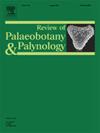Palaeobotanical and genetic data highlight the vulnerability of Picea in peninsular Italy
IF 1.7
3区 地球科学
Q2 PALEONTOLOGY
引用次数: 0
Abstract
Rear edge populations might be of disproportionate importance for the adaptation of temperate forest tree species to climate change. The study of past demographic dynamics and their effects on extant genetic diversity are therefore keys to understand how to manage these potentially relevant forest genetic resources. Here we combine a comprehensive review of palaeobotanical evidence from peninsular Italy throughout the Quaternary with new genetic data for Picea abies, focusing on all known rear edge populations from the boundary zone between the Alps and the northern Apennines, to shed light on timing and modes of the fragmentation processes leading these populations close to extirpation. Our data show that Picea abies experienced a complex Quaternary history mirrored by a concomitantly complex genetic structure. The population in the southwestern Alps and the two populations living in the northwestern Apennines appear to be the last remnants of a much wider Pleistocene distribution. During the last glacial period and the postglacial they had distinct spatiotemporal dynamics. These peripheral populations are characterized by peculiar genetic features, a substantial pairwise genetic differentiation and general genetic impoverishment, with a ∼ 20% reduction of their allelic richness with respect to other Alpine populations.
These results collectively indicate that the southernmost Italian populations of Picea abies, still present in the northern Apennines and in the southwestern Alps, are extremely vulnerable to extirpation, as already was the case with populations that progressively disappeared from southern and central Italy in the Middle and Upper Pleistocene, respectively, and from the north-eastern Apennines during the late Holocene.
古植物学和遗传学数据强调了意大利半岛云杉的脆弱性
后缘种群对于温带森林树种对气候变化的适应可能具有不成比例的重要性。因此,研究过去的人口动态及其对现存遗传多样性的影响是了解如何管理这些潜在相关森林遗传资源的关键。在这里,我们将意大利半岛第四纪的古植物学证据与新的云杉遗传数据结合起来,重点研究阿尔卑斯山脉和亚平宁山脉北部边界地带所有已知的后缘种群,以阐明导致这些种群接近灭绝的破碎化过程的时间和模式。我们的数据表明,云杉经历了一个复杂的第四纪历史,这反映了伴随而来的复杂的遗传结构。生活在阿尔卑斯山西南部的种群和生活在亚平宁山脉西北部的两个种群似乎是更新世更广泛分布的最后残余。末次冰期和后冰期具有明显的时空动态特征。这些外围种群具有特殊的遗传特征、大量的成对遗传分化和普遍的遗传贫乏,与其他高山种群相比,其等位基因丰富度降低了20%。这些结果共同表明,意大利最南端的云杉种群,仍然存在于亚平宁北部和阿尔卑斯山西南部,极易灭绝,就像在更新世中期和上更新世分别从意大利南部和中部逐渐消失,以及在全新世晚期从亚平宁东北部逐渐消失的种群一样。
本文章由计算机程序翻译,如有差异,请以英文原文为准。
求助全文
约1分钟内获得全文
求助全文
来源期刊
CiteScore
3.50
自引率
21.10%
发文量
149
审稿时长
6 months
期刊介绍:
The Review of Palaeobotany and Palynology is an international journal for articles in all fields of palaeobotany and palynology dealing with all groups, ranging from marine palynomorphs to higher land plants. Original contributions and comprehensive review papers should appeal to an international audience. Typical topics include but are not restricted to systematics, evolution, palaeobiology, palaeoecology, biostratigraphy, biochronology, palaeoclimatology, paleogeography, taphonomy, palaeoenvironmental reconstructions, vegetation history, and practical applications of palaeobotany and palynology, e.g. in coal and petroleum geology and archaeology. The journal especially encourages the publication of articles in which palaeobotany and palynology are applied for solving fundamental geological and biological problems as well as innovative and interdisciplinary approaches.

 求助内容:
求助内容: 应助结果提醒方式:
应助结果提醒方式:


